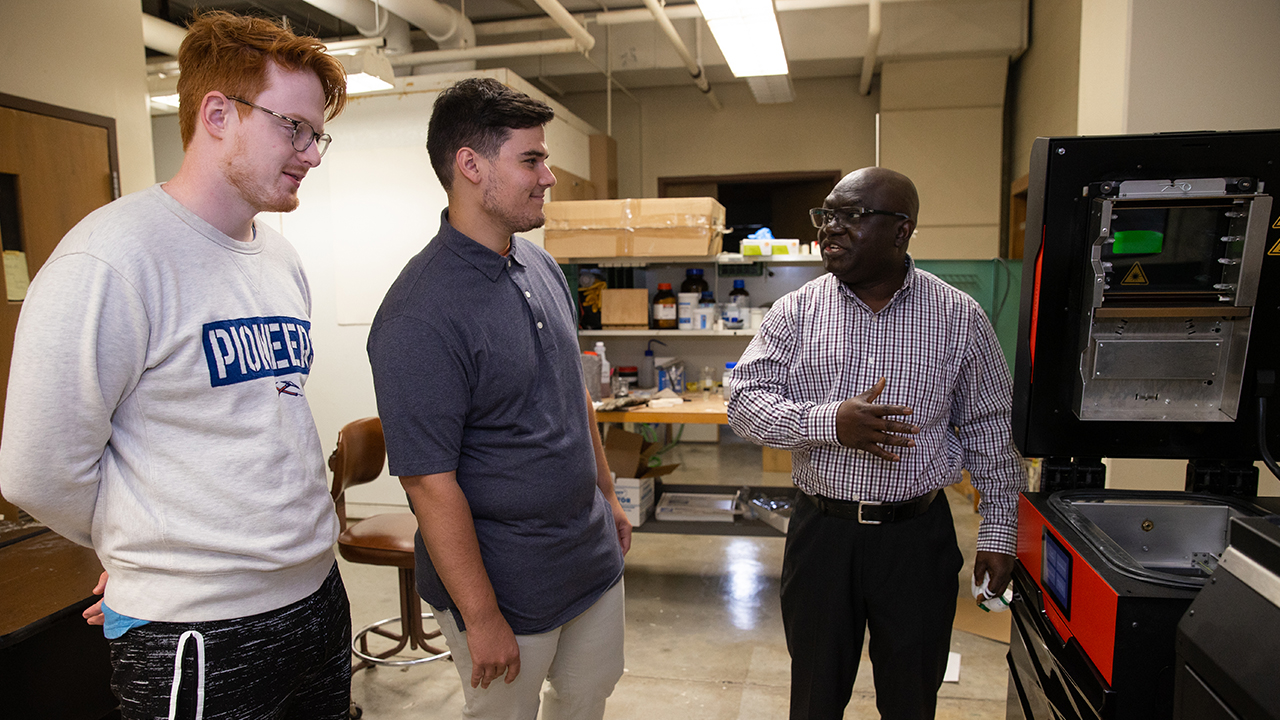
Dr. John Obielodan explains the workings of a newly acquired selective laser sintering machine to some of his students in the lab. The machine was purchased through a Dairy Innovation Hub Supplies and Equipment grant.
New inventions poised to make an impact in a variety of fields are getting their start on the University of Wisconsin-Platteville campus, being designed, prototyped and tested by a UW-Platteville faculty member and students. Thanks to a partnership between WiSys – the technology transfer arm of the 11 UW System regional comprehensive campuses – and Dr. John Obielodan, associate professor of mechanical engineering, half a dozen inventions have gone from idea to reality over the past two years.
In 2019, Obielodan assumed the role of Prototyping Center manager and WiSys scholar, through which he works with WiSys to design, re-design, modify, fabricate and test patentable products in readiness for intellectual property transfer to potential investors. According to WiSys, prototypes help validate the technical feasibility of an idea. A real-world model can help prove that a concept will address the problem that the innovator set out to solve as well as gather user feedback for technical improvements and market validation.
The projects Obielodan works on come from various UW System campuses and cover a diverse range of technological fields – from agriculture to recreation.
“The beauty of the projects and having the WiSys section of the Prototyping Center, is that I have all these different kinds of projects coming,” said Obielodan. “I never thought I would handle some of these types of projects before I took on the role.”
Some of Obielodan’s notable projects include working on a field portable smartphone device for water quality monitoring, an adhesive patch for safe application of dehorning paste with calves and a retrofit Peltier cooling device.
“The projects come in different stages, including conceptual ideas that I need to develop into devices or systems to fulfill prescribed functional requirements; some have a preliminary design, others have undergone some level of prior prototyping that requires modifications or design refinements,” said Obielodan. “All of them go through iterative processes of design, fabrications, laboratory and field testing until their functional requirements are satisfied.”
One of the benefits of the partnership with WiSys is the ability to give students a unique opportunity to play a role in the research and prototyping of these ideas. Up to 10 to 13 students assist Obielodan each year, ranging from disciplines in mechanical, electrical and software engineering to chemistry and engineering physics.
“The students learn how to solve problems, develop an experiment for research and conduct tests,” said Obielodan. “They also learn teamwork. Students range from freshmen to seniors, and I like to mix them up on projects so they learn from each other. Some of them have been motivated to go on to graduate school because of this work. They learn things that they just cannot learn in class.”
The partnership is also laying the foundation for future innovative and collaborative opportunities available once Sesquicentennial Hall, the newest engineering building on campus, opens in fall 2022. The building’s Innovation Center is slated to be one of the largest makerspaces in the Midwest and will allow students and external partners to turn their ideas into a design and prototype.
“This is a model of what we’ll have in the Innovation Center, where we can work collaboratively with individuals and small companies,” said Obielodan, who is also involved in the planning of the new Innovation Center and how it will connect with people off campus.
Obielodan’s work as Prototyping Center manager over the past two years has supported six patent filings, two of which he is listed as a co-inventor due to his contribution to improvements in design. Patenting is a process that can take several years, so while none of the patent applications have been granted yet, WiSys is hopeful about the long-term prospects of the work.
“John has been a tremendous asset to WiSys and the state’s inventors,” said WiSys’ Director of Patents and Licensing Jennifer Souter. “He brings a wealth of experience not only in engineering, but also a product development and design perspective, based on his past industry experience. Many of the ideas that come to WiSys are conceptual in nature and John has helped bring many of them to life.”
